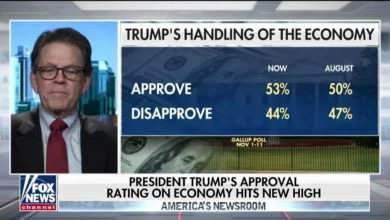Trump Budget Framework Advances in Senate GOP Vote

The Trump budget framework marks a significant moment for the Senate GOP as it pushes forward a vision that aligns closely with President Donald Trump’s economic agenda. After a lengthy series of votes that showcased party lines, the Senate approved this framework, which aims to redefine fiscal priorities, lower the debt ceiling, and make tax cuts permanent for American citizens. With only two dissenting Republicans, the vote signals a robust commitment among GOP senators to uphold core tenets of their conservative doctrine. This budget reconciliation effort equips Republicans with essential leverage, allowing them to highlight their agenda while effectively challenging Democratic opposition. As discussions unfold around economic growth, border security, and government efficacy, the Trump budget framework arises as a pivotal step in what many hope will be a transformative approach to governance.
The recent budget plan proposed by the Trump administration has generated considerable attention as it aligns with the overarching Republican agenda in Congress. This financial blueprint is designed to navigate the complexities of budget reconciliation, ultimately paving the way for significant tax benefits and a strategy to address the country’s debt ceiling. In the wake of bipartisan clashes over fiscal policies, the framework aims to solidify a path forward that prioritizes fiscal conservatism and aims to secure lasting economic policies. As the Senate grapples with varying perspectives from within the party, this budget proposal highlights the ongoing negotiations and strategic decisions that shape the financial landscape. The push for a united front among Republicans showcases a commitment to enacting policies that resonate with conservative voters and influence the national discourse.
Overview of the Senate GOP’s Push for Trump Budget Framework
The Senate GOP’s recent passage of a robust budget framework marks a significant moment in advancing President Donald Trump’s policy goals. This measure passed after an extensive series of votes, primarily along party lines, reflecting the stark divide in Congress. With a vote tally of 51 to 48, and only Senators Susan Collins and Rand Paul straying from the Republican consensus, this framework sets a foundation for transformative changes in fiscal policy and governmental efficiency.
By planning to raise the debt ceiling by up to $5 trillion, the Senate GOP aims to facilitate resources for Trump’s policy priorities, such as enhancing national security and border funding. By implementing budget reconciliation, this approach sidesteps potential Democratic objections, demonstrating the Republican agenda’s resolve to maintain Trump’s tax cuts. The debate surrounding the framework indicates a pivotal moment in setting economic policy for the foreseeable future.
Implications of Budget Reconciliation in Advancing Tax Cuts
The reconciliation process outlined in the budget framework is essential for solidifying Trump’s tax cuts from 2017, as it allows for the possibility of bypassing filibusters that could stall the legislation. By establishing a current policy baseline for these tax cuts, Senate Republicans are focusing on maximizing benefits for American taxpayers, while also addressing concerns from various factions within the party. However, Republicans like Senator Bill Cassidy express concerns about the implications of using this method, warning that it could set a precedent that could complicate future budget scenarios.
Beyond financial implications, the use of budget reconciliation illustrates the strategic importance the Senate GOP places on permanently enshrining these tax policies into law. The potential to shield these tax cuts from the ebb and flow of political dynamics reinforces the Republican agenda’s focus on long-term economic growth. As the budget framework progresses, it remains crucial for GOP leaders to ensure unity and address dissenting voices regarding how best to execute these policies.
The Role of the Debt Ceiling in the Republican Agenda
Raising the debt ceiling is a critical component of the recently passed budget framework, intended to provide the necessary leeway for implementing various elements of Trump’s political and economic agenda. This increase, allowing up to $5 trillion, is not just a matter of fiscal management but also a strategic maneuver designed to limit future Democratic influence during budget negotiations. Senate GOP leaders have made it clear: this is a decisive step towards ensuring funding for key initiatives alongside maintaining ongoing tax relief.
The backdrop of the debt ceiling debate is intertwined with concerns about national debt and fiscal responsibility. While GOP leaders seek to advance Trump’s objectives, some conservatives have voiced apprehension about the implications of perpetually increasing the debt. This balance between aggressive funding for the Republican agenda and fiscal prudence will be watched closely by both supporters and critics alike.
Responses to the Budget Framework by Key Senators
The budget framework has drawn a mix of support and criticism from within the Republican ranks. Senators like John Thune, the Senate Majority Leader, have openly endorsed the resolution, framing it as a vital step toward fulfilling campaign promises related to tax cuts and national security. In his speeches, Thune emphasized the significance of this bill in ensuring economic growth and stability, aligning closely with Trump’s overall agenda.
On the other hand, dissenting voices, particularly those from Senators Collins and Paul, highlight concerns about the potential risks associated with both the reconciliation process and the measures proposed in the framework. Their opposition serves as a reminder of the divisions that exist within the GOP, particularly regarding fiscal responsibility and the long-term implications of raising the debt ceiling. This dynamic reveals the ongoing tension between achieving immediate political goals and maintaining a sustainable economic strategy.
Future Challenges for House Republicans and the Senate Framework
As the Senate GOP celebrates the passage of its budget framework, a significant challenge looms in the House of Representatives, where Republican leaders must galvanize support among their members for a similar legislative approach. Although the House GOP passed a framework earlier that shares key elements with the Senate’s version, disagreements persist on the specifics of implementing budget reconciliation. These differences underscore the complexities of aligning both chambers on crucial fiscal policies.
Concerns from House conservatives about the Senate’s approach may lead to further negotiation and amendments. If the lower chamber rejects the Senate framework or demands significant changes, it could complicate or delay the timeline for implementing Trump’s agenda. The alignment of the Republican party across both chambers will be crucial in determining the success of these budgetary initiatives and establishing a cohesive front as they navigate upcoming fiscal challenges.
The Significance of Tariff Amendments in the Budget Debate
During the extensive voting process regarding the budget framework, several notable amendments were proposed, particularly concerning tariffs, which have been a cornerstone of Trump’s economic strategy. Senators like Bernie Sanders and Chuck Schumer raised concerns about the implications of these tariffs for American consumers and businesses, adding complexity to the budget discussions. This tug-of-war reflects the broader economic debates that will influence how Republicans approach trade and its interconnection with tax policy.
Tariff-related amendments may alter the dynamics of the budget framework as they underscore potential conflicts between fiscal policies and protectionist strategies. For Senate Republicans, supporting tariffs while also maintaining favorable tax conditions presents a dual challenge. Balancing these priorities will be key to ensuring the approved budget framework addresses both the Republican agenda and the economic realities that American families face.
Competing Visions of the Budget: House vs. Senate
The contrasting visions between the House GOP and Senate GOP regarding budget reconciliation illustrate the complexities in unifying the party’s approach. House leaders argue for a comprehensive bill that combines border security funding with tax cuts, while senators are advocating for a bifurcated strategy. This divergent approach not only reflects different priorities but also suggests a potential legislative impasse that could hinder effective governance.
As both chambers navigate their internal disagreements, they must also consider the larger implications of their decisions on the Republican agenda as a whole. By finding common ground, they can leverage their majority status to push forward critical policies that resonate with their base. However, if reconciliation fails to harmonize the visions presented by the House and Senate, it may stall key elements of Trump’s fiscal agenda that Republicans are eager to advance.
Public Perception and the Future of Trump’s Budget Agenda
Public sentiment plays a crucial role in shaping the future of Trump’s budget agenda. As the Senate GOP successfully pushes the framework, awareness among constituents about the implications of raising the debt ceiling and extending tax cuts is critical. Communication from lawmakers about these decisions will be essential in garnering public support, especially considering the potential economic impact on everyday Americans.
Moreover, as the budget framework moves forward, how well it resonates with voters will likely influence the Republican party’s standing in future elections. Republican leaders must address the concerns of dissenting voices while projecting a unified front that emphasizes economic growth and fiscal responsibility. Failure to articulate these policies clearly could lead to a backlash that affects not only Trump’s agenda but also the broader GOP framework heading into upcoming electoral cycles.
Looking Ahead: The Next Steps in Budget Enforcement
With the Senate’s passage of the budget framework, the next steps involve detailed discussions on enforcement mechanisms and ensuring compliance with the outlined financial goals. The challenges associated with implementing the budget reconciliation effectively will require careful oversight and commitment from GOP leadership. Establishing frameworks for transparency and accountability will be paramount as the Senate embarks on this new fiscal course.
Senate GOP leaders must also remain vigilant against potential backlash or modifications proposed by House Republicans, as differing opinions could disrupt the implementation of the framework. Coordinated efforts to reinforce the key components of the budget, such as permanent tax cuts and funding for government efficiency, will be essential for maintaining momentum. As they move forward, GOP leaders will need to balance ambition with pragmatism to achieve a successful outcome for Trump’s economic vision.
Frequently Asked Questions
What is the Trump budget framework that the Senate GOP is pushing through?
The Trump budget framework is a legislative proposal aimed at promoting President Donald Trump’s agenda, which includes raising the debt ceiling by up to $5 trillion and making the 2017 tax cuts permanent. The framework was passed by the Senate GOP primarily along party lines in a 51 to 48 vote.
How does the Trump budget framework relate to budget reconciliation?
The Trump budget framework utilizes budget reconciliation, a process that allows for expedited consideration of certain tax and spending legislation. This framework aims to raise the debt ceiling and secure Trump’s tax cuts while limiting the influence of Senate Democrats in future negotiations.
Why did some Republicans oppose the Trump budget framework?
Senators Susan Collins and Rand Paul opposed the Trump budget framework, expressing concerns over the financial implications, particularly regarding the method of making Trump’s tax cuts permanent and the potential precedent it sets for future legislation.
What impact will the Trump budget framework have on tax cuts?
The Trump budget framework is designed to make the tax cuts implemented in 2017 permanent. By employing a current policy baseline through the reconciliation process, it seeks to secure these tax benefits amidst ongoing discussions about fiscal responsibility.
How does the Trump budget framework affect the debt ceiling discussions?
The Trump budget framework proposes raising the debt ceiling by up to $5 trillion. This move is strategic, as it seeks to diminish future leverage that Senate Democrats might have during negotiations related to government funding and fiscal policies.
What other key issues are addressed in the Trump budget framework?
In addition to tax cuts and the debt ceiling, the Trump budget framework aims to include funding for border security and outlines several reforms and savings measures intended to enhance governmental efficiency in line with the Republican agenda.
What are the potential risks of the Trump budget framework as noted by its critics?
Critics, like Senator Bill Cassidy, highlight the risks associated with using a current policy baseline for the Trump budget framework, suggesting it could set a dangerous precedent for future budgetary practices, even if it adheres to the rules of reconciliation.
How did the Senate GOP leaders respond to the Trump budget framework?
Senate GOP leaders have shown strong support for the Trump budget framework, viewing it as a crucial first step towards finalizing a bill that guarantees the permanence of the 2017 tax cuts while addressing key areas like national security and government reform.
What challenges might the Trump budget framework face in the House?
Despite its similarities to the House GOP’s previous framework, the Trump budget framework may face challenges in the House due to divisions among conservatives about how to approach the reconciliation process and whether to combine border security funding with tax relief initiatives.
What are the implications of the Trump budget framework on the Republican agenda?
The Trump budget framework embodies essential components of the Republican agenda by seeking to solidify tax cuts, increase funding for border security, and employ budget reconciliation as a means to advance legislative goals more effectively amid a divided Congress.
| Key Points | Details |
|---|---|
| Senate Vote Outcome | 51 to 48 in favor, with Susan Collins and Rand Paul opposing. |
| Debt Ceiling Increase | The framework proposes raising the debt ceiling by up to $5 trillion. |
| Tax Cuts Permanence | It aims to make Trump’s 2017 tax cuts permanent through a new baseline method. |
| Republican Unity | Despite some dissent, Senate GOP leaders strongly support the framework. |
| Key Amendments Proposed | Notable amendments included increasing the minimum wage and limiting tariffs. |
| House vs Senate Approach | Differences in strategy lead to uncertainty about unifying frameworks between chambers. |
| Trump’s Support | Trump endorses the Senate framework, highlighting its potential impact. |
Summary
The Trump budget framework signifies a critical step in advancing key elements of President Trump’s agenda within Congress. Passed after a contentious late-night vote, the framework highlights the GOP’s commitment to raising the debt ceiling and making past tax cuts permanent, amidst a politically charged environment. The strong party-line support emphasizes the importance Republicans place on this budget resolution as a vehicle for significant legislative change.




